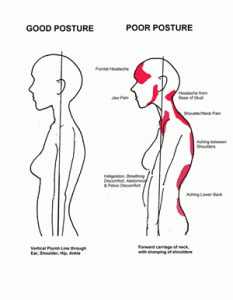
What is All the Ado About Sitting? Sitting, Posture & Your Health
Jun 27, 2022Let’s talk too much sitting. There is ample research showcasing the correlation between sitting too long and a slew of health issues. Sitting too long has been found to be correlated to cardiovascular disease (e.g., heart attacks and strokes), diabetes, weight gain, cancer, high blood pressure, edema, loss of concentration, and the list keeps going.
In this blog, we discuss the impact of sitting on your posture and the consecutive not-so-favorable results. When you sit for too long without moving, chances are, you are not going to sustain proper alignment. Alter your alignment once or twice – not a biggie. Alter your alignment consistently – it becomes your new go-to posture.
“Look well to the spine for the cause of disease."
Hippocrates, Greek physician and the Father of Western Medicine
Now, answer the questions below.
- Do you cross your legs and transfer weight to one butt cheek consistently?
- Do you like to bend a knee and sit on that leg?
- Are you leaning sideways?
- Is your head constantly leaning forward to look at the screen?
- Is your body twisted to accommodate looking at two screens?
Did you answer "Yes" to any of these? Then keep reading.
Slouching, shoulders rounded forward, chest closed up, chin tilted down, head forward, pelvis tilted front, back, or sideways are all options for how your body is adapting to your sitting habits.

Add to the equation any prior injury or surgery which would have weakened one or multiple body parts, it is a cocktail for long-term disaster. And while we are conditioned to look at issues in isolation, years of teaching have demonstrated that one issue turns into a full-body disfunction.
Some muscles lengthen, and their opposing counterparts shorten. Your body is brilliant like this – it will adapt to sustain what you are asking it to do. The danger is when these adaptation patterns are not corrected over time – your body gets exhausted from being out of its homeostasis state. Aches and pains kick in to get your attention.
For many, the fix is a pill pop or magical lotion slap to dull the pain. Who has time to deal with pain and investigate its causes? Plus, isn’t pain a part of normal aging?
No, the pain is not normal. Pain is your body’s cry for help.
Warning signs afore pain are tightness and stiffness, altered mobility, muscle spasms, occasional nerve pinching, and, over time, a change in your natural posture.
"Posture affects and moderates every physiological function from breathing to hormonal production."
American Journal of Pain Management
In natural posture, knees stack on top of ankles, hips stack on top of knees, shoulders stack on top of hips, head aligns with your shoulders.

Image by Beth Scupham
Your front visual ‘box’ looks like a rectangle drawn shoulder to shoulder and hip to hip.
Do you own a rectangle or maybe a rhomboid (where the shoulder and hip on one side are lower than on the other)?
- Is your head stacked on top of your shoulders?
- Are the shoulders stacked on top of the pelvis?
- Is your pelvis tilted forward or backward?
- Are you locking your knees?
- Do you sit in your heels or balls of feet?
- Do you roll your feet out or roll your feet in?
If you would like a visual, get my six-minute overview of how to get into physical alignment.
While it may appear the above are cosmetic in nature only, the truth is, that any of the above deviations have functional implications.
“The beginning of the disease process begins with postural distortions”
Dr. Hans Selye, Nobel Laureate
For example:
- Sitting slouched places uneven pressure on the different vertebras.
- A posterior or anterior tilt in your pelvis will change the natural curve of the spine and place unequal pressure on the back or front of each individual vertebrae.
- In either of the above cases, numbing due to increased nerve pressure and limited signaling or shock-like pain due to nerve impingement may result. The nerve supply to the corresponding muscles and organs is diminished.
- Poor posture yanks the body out of its homeostatic state; as compensations occur, some muscles work harder, and other muscles get lazy. For the latter, muscle atrophy happens over time.
- Balance and stability are impaired.
- When you sit too long and recurrently, your joints stiffen; spinal flexibility is reduced.
- When the pelvis moves abnormally, pelvic floor dysfunction is born.
- When the pelvis is out of alignment, the hips joints are stressed; gait may be impacted (and hence balance).
- Slouching shrinks the chest cavity – lungs are compressed; breathing is impaired
- Lack of circulation causes restricted blood and oxygen flow to the brain (bye, bye concentration and focus) as well as the heart (hello cardiovascular diseases).
To name a few, any of these conditions could be the result of too much sitting and impacted posture:
- Altered posture
- Osteoarthritis
- Low back pain
- Hip pain
- Sciatica issues
- Sacroiliac joint pain
- Knee pain
- Loss of balance and stability
- Digestive issues
- High blood pressure
- Premature joint wear and tear
- Accelerated body degeneration
- Chronic Fatigue
- Diastasis recti
- Urinary incontinence
- Headaches
- Painful sex
- Constipation
- Limited mobility
- Stiffness/ achiness
Aside from injuries, the most frequent causes of pain I see in my practice are due to altered pelvis position, wobbly pelvis, and tight flexors.
Now, what can you do to age actively? Keep moving!
- Set a reminder to move for a few minutes on the top of each hour
- Take a longer moving break during lunch
- Strengthen your core muscles
- Stretch regularly
- Alternate between sitting and standing
- Be intentional about how you sit and stand; pay attention to your alignment
- Make it a daily priority to move 30 minutes minimum
- Do not ignore warning signs or pain
If you happen to be sitting right this minute, here is a 5-minute seated stretches video you can take advantage of and get your body moving pronto.
Happy Moving, rebels!
Stay connected with news and updates!
Join our mailing list to receive the latest news and updates from our team.
Don't worry, your information will not be shared.
We hate SPAM. We will never sell your information, for any reason.


